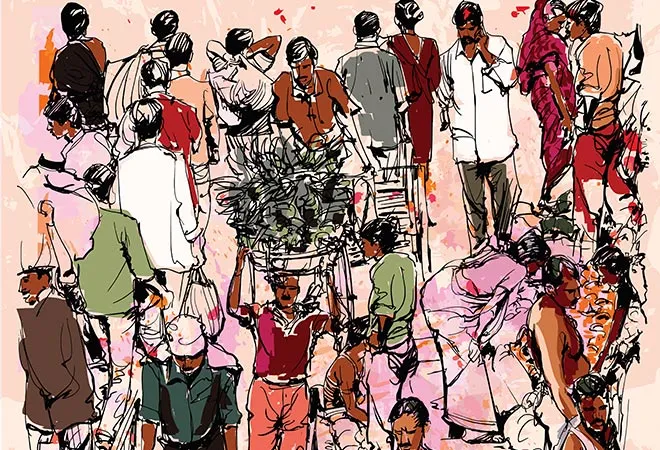-
CENTRES
Progammes & Centres
Location
Unlike the ‘area sabha’ of the Nagar Raj Bill, the decisions of the ‘jan sabha’ were to be binding on the wards committee in regard to local works and moneys within the budget allocated to the ward.

The virtues of grassroots empowerment and its contribution to the consolidation of a healthy democracy have been recognised for long. Tocqueville, the 19th century French political scientist and historian, held that “local institutions constitute the strength of nations. A nation may establish a system of free government but without local institutions, it cannot have the spirit of liberty.” Gandhi’s views about grassroots democracy were even stronger. He considered democracy as essentially meaning the comprehensive mobilisation of resources of all the people for the common good of all. It is true that his cited articulation was in the context of the village. In the 1990s, these ideas, through the Constitution (seventy-third) Amendment Act got embedded in the ‘gram sabha,’ defined by the Indian Constitution as “a body consisting of persons registered in the electoral rolls relating to a village comprised within the area of panchayat at the village level.” In the urban context, however, participatory democracy found no resonance in the Constitution (seventy-fourth) Amendment Act. Perhaps, the demographic profile of large urban local bodies and the difficulties in fitting them into an ‘urban sabha’ may have led the framers of the Act to bypass the idea.
Globally, however, in the democratic world, the constructs of urban governance have continued to press forward in the direction of grassroots empowerment. The typical institutional design of voting once in five years and thereafter relinquishing all local governance to the councillors does not seem to satisfy citizens any longer, more so on account of examples of misgovernance and malfeasance. These factors have convinced citizens, urban thinkers and activists that there needs to be a greater direct role for residents in local decision-making. The role of technology in such an envisaged role-change for citizens has been monumental. Social media movements, despite aberrations, have gathered great strength across the democratic world. Online platforms of community interaction have brought in transparency of an order that authorities were unwilling to concede. As a consequence, governments have had to cede democratic space to the citizenry and bring about changes in the existing democratic template of local governance.
The typical institutional design of voting once in five years and thereafter relinquishing all local governance to the councillors does not seem to satisfy citizens any longer, more so on account of examples of misgovernance and malfeasance.
The democratic struggle of the urban citizenry has yielded significant results in Western Europe. Several European cities have formal, citizen consultation processes, though many of these have not been without problems. In Switzerland, 50,000 citizens can sign up for a referendum on a matter of significance. A referendum, thereafter, is ordered under law. Referendums can be held at federal, cantonal or communal (local) level. This system makes Switzerland the leading country practicing direct democracy and where citizen participation is institutionalised. Most countries of Western Europe have highly evolved consultative processes that local governments cannot trifle with or sidestep. Developed Asian countries have walked the same path. Since the 1990s, South Korea has been cementing the relationship between the government and citizens with a view to reinforce public trust in government and public institutions, to respond to citizens’ expectations and get their buy-in. The Japanese use a novel approach in urban planning called Machizukuri, essentially referring to a variety of actions that residents and local governments take in partnership towards decision-making.
In India, despite the shortcomings of the 74th Amendment Act, several subsequent attempts have been made to provide platforms for citizen deliberation. Government of India tried to inject consultation strategies into city-based deliberations through national schemes that they crafted. For instance, the Smart Cities Mission requires the preparation of a Smart City Proposal (SCP) as a collaborative effort that includes consultations with citizens. Earlier, the Jawaharlal Nehru National Urban Renewal Mission (JnNURM) provided for citizen consultation in the preparation of City Development Plans (CDP). The assemblage of these citizen’s groups, however, were ad hoc. The civic authorities themselves put these together, based on their local understanding and the usefulness of the individuals selected.
Government of India tried to inject consultation strategies into city-based deliberations through national schemes that they crafted. For instance, the Smart Cities Mission requires the preparation of a Smart City Proposal.
The most concerted national attempt towards citizen empowerment was made in the shape of the Model Nagar Raj Bill that was dovetailed with the JnNURM. This was framed by Government of India in 2005 and state governments were advised to take it up for legislation. This move was much beyond anything that was attempted in the past. While the earlier attempts were improvised in the context of specific schemes, the Nagar Raj Bill was intended to be a permanent part of the governance architecture of cities. In order to have the Bill legislated by the states, the disbursement of funds to the states under the JnNURM were made conditional on compliance with the passage of this Bill.
The key consultative mechanism the Model Nagar Raj Bill invented was the Area Sabha, defined as “the body of all the persons registered in the electoral rolls pertaining to every polling booth in the Area in a Municipality.” An area sabha was to be set up for a geography comprising a maximum of five contiguous polling booths, represented by an area sabha representative and a process was prescribed for the conduct of its election. The representative was to hold office for a term co-terminus with that of the municipality.
Government of India’s initiative, however, found little resonance in the states. About a dozen states passed the community participation law providing for ‘area sabha.’ However, the letter and spirit of the Nagar Raj Bill was destroyed through amendments designed to keep the citizens away from the local decision-making process. This was despite the fact that the ‘area sabha,’ while given a statutory basis under the Nagar Raj Bill, was still merely advisory and not binding on the municipal decision-making process.
The term of ‘jan sabha’ members was to be co-terminus with that of the ULB and none of them would be eligible for re-election.
In this regard, a further set of recommendations that were made would be worth mentioning. In March 2017, Government of Maharashtra appointed a three-member committee called the ‘Committee on Transparency, Efficiency and Accountability in Urban Local Bodies.’ It submitted its report a year later. In an attempt to deepen the participative democratic process, it recommended the constitution of the ‘jan sabha’ at the electoral ward level with a maximum of one hundred members or less as determined by the state.
Elections to the ‘jan sabha’ were to be held booth-wise from the voters in that booth’s electoral list. Such elections would be conducted by the ULB or an apparatus ordained by the state along with the municipal elections. The term of ‘jan sabha’ members was to be co-terminus with that of the ULB and none of them would be eligible for re-election. The law was required to insert provisions that mandated equitable representation to various stakeholders. If the size of the ULB was small, every voting citizen could be a member of the ‘jan sabha’ on the lines of the ‘gram sabha’. Its functions would pertain to municipal issues in the geographical area of that ward. It would meet every month and a small number of functionaries were to be allocated to enable the functioning of the ‘jan sabha.’
It is necessary to point out that unlike the ‘area sabha’ of the Nagar Raj Bill, the decisions of the ‘jan sabha’ were to be binding on the wards committee in regard to local works and moneys within the budget allocated to the ward. The Transparency Committee recommended a well-structured financial layout for the ‘jan sabha’. However, actual works were to be carried out by the administrative apparatus of the wards committee as an administrative implementation apparatus for each separate ward was not envisaged. The ‘jan sabha’ was also empowered to carry out ‘social audit’ of works within its boundaries. Unfortunately, no follow-up steps have been taken to translate the recommendations of the Committee into reality. It appears the citizens would have to launch a more robust struggle for a larger local role.
The views expressed above belong to the author(s). ORF research and analyses now available on Telegram! Click here to access our curated content — blogs, longforms and interviews.

Dr. Ramanath Jha is Distinguished Fellow at Observer Research Foundation, Mumbai. He works on urbanisation — urban sustainability, urban governance and urban planning. Dr. Jha belongs ...
Read More +